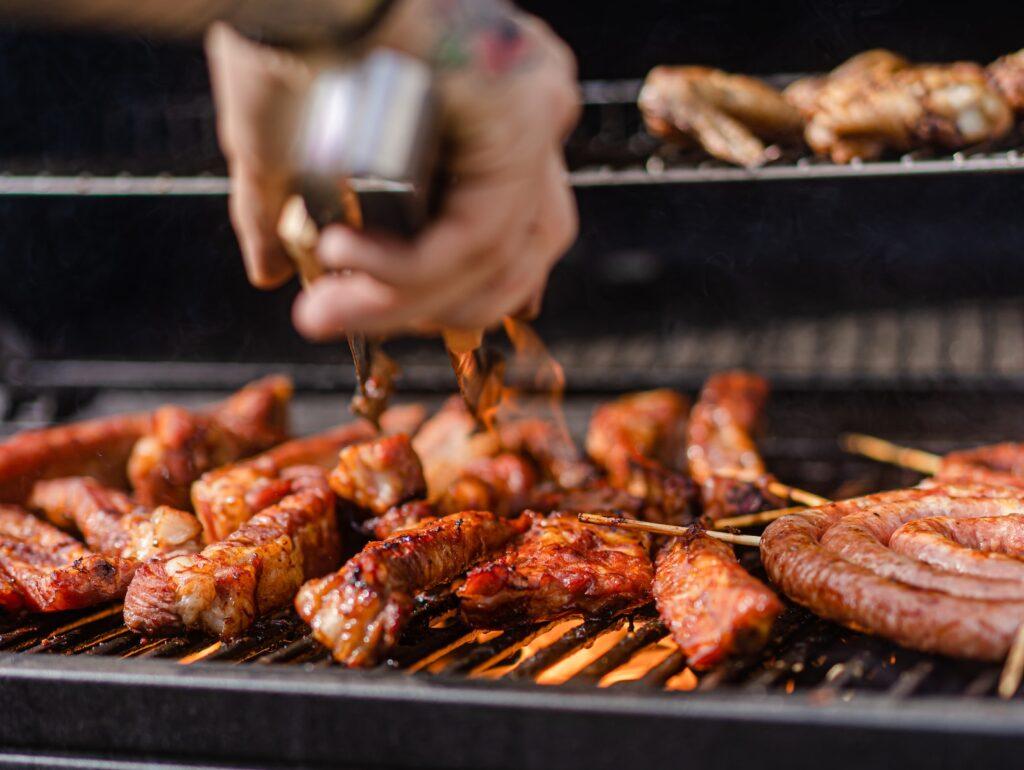Grilling is more than just cooking food; it’s a cherished tradition and a delightful way to enjoy the great outdoors. Whether you’re a seasoned grill master or a beginner, mastering the art of grilling techniques is key to achieving those perfectly grilled meals that make your taste buds sing. In this quick guide to grilling, we’ll dive into the world of grilling and equip you with the basic knowledge and skills to become a grilling pro!

Guide to Grilling: Understanding the Basics
Before we dive into the nitty-gritty of grilling techniques, let’s start with the basics. First things first, you need to know your grill! Whether you prefer a gas, charcoal, or pellet grill, understanding its features and how to operate it will set you on the path to grilling success.
Gas Grill: Familiarize yourself with the burner controls, ignition system, and temperature settings. Make sure the gas tank is properly connected and has enough fuel for your grilling session.
Pellet Grill: Understand the pellet hopper, temperature control system, and pellet selection for different flavor profiles.
Wood Smokers: Smokers can be used to add unique flavor to your food and can be combined with gas, charcoal or pellet grills. Read our review of the Best Gas Grill Smoker Combos.
Additionally, make sure you have essential grilling tools like tongs, spatula, grill brush, and a reliable meat thermometer.
Guide to Grilling: Preparing for Grilling Success
Now that you’re equipped with the right tools, it’s time to prepare for grilling success. Choosing quality ingredients is paramount. Opt for fresh, high-quality meats and produce that will elevate your dishes.
Meat Selection: Look for cuts that are suitable for grilling, such as steaks, burgers, chicken breasts, pork chops or even fish. Choose meats with good marbling and even thickness for even cooking.
Marinating and Seasoning: Marinating your meats not only adds flavor but also helps tenderize them. Experiment with different marinades and spice rubs to enhance the taste. Allow your meats to marinate and absorb the flavors for at least 30 minutes to a few hours before grilling.
Vegetable Preparation: Wash and dry your vegetables thoroughly. Slice them into even pieces or use skewers for grilling kabobs. Lightly coat with oil and season with salt and pepper or your favorite seasonings.
Mastering Grilling Techniques
Direct Heat Grilling
Direct heat grilling is perfect for quick-cooking items like burgers, steaks, and vegetables. To achieve those beautiful sear marks and juicy results, follow these steps:
- Preheat the Grill: Preheat your grill to high heat. This ensures that the grates are hot and ready for searing.
- Oil the Grates: Prevent sticking by oiling the grates. Dip a folded paper towel in cooking oil and, using tongs, rub it across the grates.
- Prepare the Food: Pat the meat dry with a paper towel to promote caramelization. Season both sides with salt, pepper, or your preferred seasonings.
- Grilling Techniques: Place the food directly over the heat source. For thick cuts of meat, start with high heat to sear both sides, then reduce the heat and continue cooking until desired doneness. Flip the items once halfway through cooking for even browning.
Try delicious recipes like classic juicy burgers or mouthwatering grilled asparagus.
Indirect Heat Grilling
Indirect heat grilling is your go-to technique for larger cuts of meat or delicate foods that require gentle cooking. Here’s how to do it:
- Prepare the Grill: For a charcoal grill, light the charcoal on one side of the grill and leave the other side empty. For a gas grill, preheat one side of the grill and leave the other side off or at a low temperature.
- Food Placement: Place the food on the side of the grill without direct heat. This allows for slow, even cooking without charring or burning.
- Cover the Grill: Close the grill lid to create an oven-like environment. This helps retain heat and circulate it around the food for even cooking.
- Temperature Monitoring: Use a grill thermometer to monitor the internal temperature of the food. This ensures it reaches the desired level of doneness without overcooking.
Indirect heat grilling is ideal for cooking a succulent whole chicken, a tender rack of ribs, or delicate fish fillets.
Smoking on the Grill
Smoking adds a distinctive flavor to your grilled dishes and is a favorite technique for barbecue enthusiasts. To achieve that irresistible smoky goodness, follow these steps:
- Prepare the Grill: For charcoal grills, light the charcoal and let it burn until covered with a layer of white ash. Create a small indentation in the middle of the charcoal bed to hold the wood chips or chunks. For gas grills, use a smoker box or aluminum foil pouch filled with soaked wood chips.
- Soak the Wood Chips: Soak wood chips or chunks in water for at least 30 minutes to prevent them from burning too quickly.
- Add the Wood Chips: Place the soaked wood chips or chunks directly onto the charcoal or in the smoker box/pouch for gas grills.
- Control the Temperature: Maintain a low and steady temperature in the grill. This can be achieved by partially closing the vents or adjusting the burner knobs on a gas grill.
Smoking is perfect for creating delectable smoked ribs, pulled pork, or even a homemade smoked pizza.
Safety Tips
Grilling is a fun and delicious activity, but it’s essential to prioritize safety. Follow these safety tips to ensure a worry-free grilling experience:
- Proper Grill Placement: Place your grill on a stable and non-flammable surface away from structures or overhanging branches.
- Keep a Safe Distance: Maintain a safe distance between the grill and any flammable objects, including furniture, plants, or curtains.
- Grill Ventilation: Ensure proper ventilation to prevent the buildup of carbon monoxide. Never grill in an enclosed space or indoors.
- Grill Maintenance: Regularly clean your grill to prevent grease buildup, which can lead to flare-ups. Check gas connections and inspect for any damage or wear.
By adhering to these safety guidelines, you can enjoy your grilling adventures with peace of mind.
FAQs
Q: How long should I marinate meats before grilling?
A: The marinating time depends on the type and thickness of the meat. Generally, it’s recommended to marinate meats for at least 30 minutes to overnight. Thicker cuts may require longer marinating times to allow the flavors to penetrate the meat fully.
Q: What are the best types of wood for smoking on the grill?
A: Different types of wood impart unique flavors to smoked dishes. Popular options include hickory, mesquite, apple, cherry, and oak. Hickory offers a strong and smoky flavor, while fruitwoods like apple and cherry provide a sweeter and lighter taste. Experimenting with different wood types can help you discover your preferred flavors.
Q: How do I know when my grilled meats are done cooking?
A: The best way to determine if your grilled meats are cooked to perfection is by using a meat thermometer. Insert the thermometer into the thickest part of the meat without touching bone or grill grates. Refer to a temperature guide to ensure the meat reaches the appropriate internal temperature for doneness.
Q: Can I grill frozen meats?
A: It is generally recommended to thaw meats before grilling to ensure even cooking. However, in some cases, you can grill frozen meats by adjusting the cooking time and temperature. Keep in mind that grilling frozen meats may result in uneven cooking and longer cooking times.
Q: What safety precautions should I take while grilling?
A: Grilling safety is crucial to prevent accidents or foodborne illnesses. Here are some important precautions to follow:
- Always grill in a well-ventilated area away from flammable materials.
- Keep a fire extinguisher nearby.
- Use long-handled grilling tools to prevent burns.
- Clean and preheat the grill properly.
- Avoid cross-contamination by using separate utensils for raw and cooked foods.
- Ensure meats are cooked to the recommended internal temperatures.
Feel free to adjust or customize the FAQs and answers based on your specific needs and the target audience of your website.
Conclusion
Congratulations! Armed with this ultimate guide to grilling techniques, you’re well on your way to becoming a grilling pro. Remember to understand your grill, prepare your ingredients thoughtfully, and master the art of direct heat grilling, indirect heat grilling, and smoking. Safety should always be a priority, so follow the recommended safety tips throughout your grilling journey.
Now, gather your loved ones, fire up the grill, and let the tantalizing aromas and mouthwatering flavors take center stage at your next backyard cookout. Happy grilling!
Last updated: September 24, 2023

